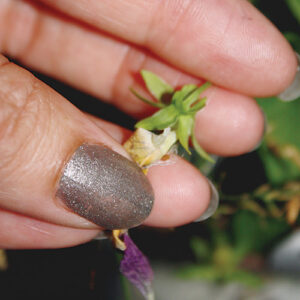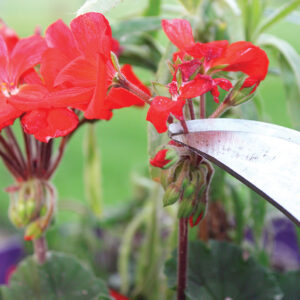Deadheading
Off with their heads! How and why you need to deadhead

New gardeners sometimes shy away from cutting back their plants or deadheading. They don’t realize that these actions will help, not harm their plants.
Deadheading is done for several reasons including lengthening the blooming period and keeping plants tidy and lush. Cutting back is also good for your plant’s health. Even if the plant doesn’t rebloom, a trim allows it to regain some of the energy spent on reproduction and divert it into maintaining its overall health.
In some cases, as with certain shrubs and bulbs, deadheading will increase flowering the following year. Gardeners plagued by heavy seeders such as lamb’s ear can decrease their spread by cutting off flower stalks before they seed.
Why plants need deadheading

Flowers are produced by plants as a means of reproduction. Once the flowers are spent the plant begins to focus all of its energy on seed production. When we pinch off dead or dying flowerheads, we are in fact preventing the plant from achieving its end goal, to produce seed. The benefit for us as gardeners is that the plant continues to try and reproduce by making more flowers! Trims improve the look and health of your plant plus enhance their flowering performance with a second, longer lasting bloom.
When deadheading plants, you need to remove more than just the petals. You should clip back the whole seed producing organ. If the flower is atop a long single stem, you can cut off the stem at its base or at the first leaf nodule. When there are unopened buds on the stalk you are cutting, just remove the seed heads of the wilted flowers.
Prevent midsummer fading

When you first bought your hanging baskets in the spring, they were gloriously full and awash with blooms, but by mid-summer they can start to look sparse and spindly. You can try to keep up, removing dead flower heads as they appear, or wait until several flowers begin to fade and give the entire basket a good haircut. To keep your baskets looking full and pretty they should be trimmed back by a third at least twice per growing season, and anytime they begin to look scraggly. Fertilize weekly or use a long-lasting, slow-release fertilizer in the spring and again in mid-June. You will have baskets looking just like they did when you first bought them right up until fall.
Annuals and perennials in flower beds benefit from a mid-summer haircut. Salvias, daisies, peonies and other perennials look much tidier after the spent blossoms have been removed.
What is a self-cleaning plant?
Today there are plants available which are self-cleaning. For example, some petunias and calibrachoa hybrids will drop their flowers once they fade. You don’t need to remove the seed organ as these varieties have been bred not to reproduce. Therefore, no deadheading for you, but as with all things that are too good to be true, there is a catch. Varieties are often limited and you may not be able to get the plant or colour you desire.
If you’re not sure if your plants are self-cleaning or not, deadhead anyways. It will still benefit your plant, allowing it to bush out.

Added benefit
Some gardeners abhor the chore of deadheading but it does provide you with an opportunity to get up close and personal with your plants. As you inspect the plant for spent flowers you can also keep and eye out for the beginning signs of disease or pests. Besides who wouldn’t like more time to spend talking to their plants?
When not to cut back
Not all flowers need to be deadheaded, in fact, there are several you won’t want to cut back for different reasons. The pasque flower, for instance, has such beautiful seed heads that many gardeners do not give them a trim. Other plants like sunflowers, Echinacea and the like produce seeds or fruit that birds will thank you for leaving behind in the fall. d
By Tania Moffat






